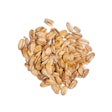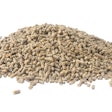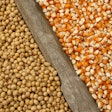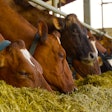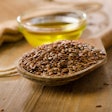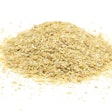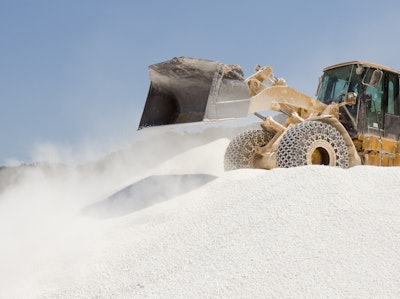
Calcium is one of the most critical nutrients for poultry, particularly laying hens, as it plays a central role in the formation of strong, high-quality eggshells. Without a reliable calcium source, hens may experience reduced egg production, weaker shells and even skeletal problems.
Among the most common calcium sources are limestone, and feed-grade calcium carbonate. In contrast, marble dust is practically free in areas where marble is extracted and, as such, it is being used extensively instead of limestone. In this article, we will explore how these calcium sources differ in terms of solubility, bioavailability and consistency, focusing on their impact on poultry layers’ performance.
Marble dust: A potential, but less common, calcium source
Marble dust is composed almost entirely of calcium carbonate (CaCO₃), typically of 95% to 99% purity. As a result, it appears to be an excellent calcium source for poultry, particularly in terms of minimizing impurities. However, marble’s crystalline structure — formed under high heat and pressure during the metamorphic process — poses challenges in its use as a feed supplement.
The crystalline structure of marble dust results in slower dissolution in the digestive system of poultry. Compared with limestone, marble dust dissolves more slowly, meaning layers may not absorb enough calcium in a timely manner to support efficient eggshell formation. Even when finely ground, the solubility of marble dust remains restricted, making it less effective for birds that need immediate calcium.
Using marble dust in different particle sizes — a common practice with limestone — can improve calcium availability throughout the day. Fine particles (<1 mm) of marble dust would dissolve more quickly, providing immediate calcium to the birds. However, even these fine particles are not as readily available as those of limestone. Coarser particles (1–4 mm) dissolve even more slowly, meaning such calcium may be available throughout the day. The overall slower dissolution limits the practicality of marble dust in supporting layer performance unless particle size distribution and percentage inclusion level is monitored closely.
In addition, marble dust has the advantage of fewer contaminants, such as heavy metals and fluoride, compared with mined limestone. Purity is important, and it is a good reason for marble dust to be investigated further as a source of calcium for layers.
Limestone: The standard calcium source with variable quality
Limestone is the most widely used calcium source in poultry feeds. Like marble, limestone is primarily composed of calcium carbonate, with a concentration typically ranging from 85% to 97%. However, the calcium concentration in limestone is highly variable depending on its source, which can directly affect the performance of laying hens.
Limestone is known for its superior solubility, which is crucial for ensuring calcium availability in poultry. Fine limestone particles dissolve quickly in the bird’s digestive system, providing immediate calcium when needed for eggshell formation. Coarser particles, on the other hand, dissolve more slowly, offering a sustained release of calcium that supports hens during the time between feedings, particularly overnight.
One challenge with limestone is its variable and often unknown calcium concentration. While some limestone sources may offer as much as 97% calcium carbonate, others may provide less, closer to 85%, or even less than that. This variation can affect layer performance. If the calcium concentration is too low, hens may not receive adequate calcium to maintain optimal eggshell quality. Poor-quality eggshells can lead to breakage and reduced productivity. Producers using limestone should be aware of this variability and ensure they source high-calcium, feed-grade limestone of guaranteed calcium concentration to prevent any negative impact on egg production and shell quality.
Limestone of unknown origin may contain trace contaminants such as fluoride and heavy metals, depending on its origin. However, feed-grade limestone is processed to minimize these risks, ensuring a safe and effective calcium source. As long as a reliable supplier is used, limestone remains an excellent calcium source for poultry layers.
Feed-grade calcium carbonate: a consistent and high-purity option
Feed-grade calcium carbonate is a highly refined and standardized form of calcium carbonate, typically derived from limestone. It is specifically processed for animal feeds to ensure optimal purity, solubility and bioavailability. Feed-grade calcium carbonate typically contains 95% to 99% calcium carbonate, offering a high degree of consistency compared with raw limestone.
Benefits of feed-grade calcium carbonate
- Purity: It has very few impurities, with strict limits on contaminants such as heavy metals and fluoride as most products are branded.
- Solubility: It is processed to ensure high solubility, meaning it dissolves quickly and is easily absorbed by the birds, providing a reliable calcium source for strong eggshells.
- Consistency: Unlike limestone, which can have variable calcium concentrations, feed-grade calcium carbonate offers consistent quality and particle size, ensuring predictable results in egg production and shell strength.
Choosing the right calcium source for poultry layers
When choosing a calcium source for poultry layers, key factors are solubility, availability and consistency. While marble dust offers a high-purity calcium source, its lower solubility and slower dissolution make it less effective for meeting the rapid calcium needs of laying hens.
Limestone, despite its variable calcium concentration, remains the most popular choice due to its superior solubility and ability to deliver immediate and sustained calcium. Producers should be mindful of limestone’s calcium variability and source high-quality, feed-grade limestone to avoid any negative impact on egg production and shell quality.
For those seeking maximum consistency and purity, feed-grade calcium carbonate is the best option. Its high solubility and standardized production make it an ideal choice for ensuring optimal calcium intake for poultry layers, resulting in consistent egg production and strong, high-quality eggshells.
In conclusion, while limestone remains the standard choice, feed-grade calcium carbonate offers a refined and reliable alternative, particularly when consistency and performance are paramount in poultry nutrition. Finally, marble offers the benefits of purity and high calcium concentration, but its use remains localized and, as such, not much research has been generated.






